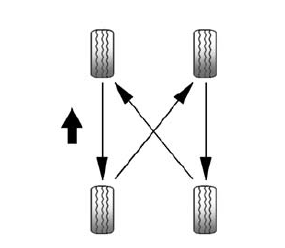Chevrolet Spark Owners Manual: Tire Rotation
Tires should be rotated every 12 000 km (7,500 mi). The first rotation is the most important.
See Maintenance Schedule on page 11-3.
Tires are rotated to achieve a more uniform wear for all tires.
Anytime unusual wear is noticed, rotate the tires as soon as possible, check for proper tire inflation pressure, and check for damaged tires or wheels. If the unusual wear continues after the rotation, check the wheel alignment. See When It Is Time for New Tires on page 10-49 and Wheel Replacement on page 10-54.

Use this rotation pattern when rotating the tires.
Adjust the front and rear tires to the recommended inflation pressure on the Tire and Loading Information label after the tires have been rotated. See Tire Pressure on page 10-43 and Vehicle Load Limits on page 9-9.
Reset the Tire Pressure Monitor System. See Tire Pressure Monitor Operation on page 10-45.
Check that all wheel nuts are properly tightened. See “Wheel Nut Torque” under Capacities and Specifications on page 12-2.
Warning
Rust or dirt on a wheel, or on the parts to which it is fastened, can make wheel nuts become loose after a time. The wheel could come off and cause a crash. When changing a wheel, remove any rust or dirt from places where the wheel attaches to the vehicle. In an emergency, a cloth or a paper towel can be used, however, use a scraper or wire brush to remove all rust or dirt.
Lightly coat the center of the wheel hub with wheel bearing grease after a wheel change or tire rotation to prevent corrosion or rust build-up. Do not get grease on the flat wheel mounting surface or on the wheel nuts or bolts.
 Tire Inspection
Tire Inspection
We recommend that the tires, including the spare tire, if the vehicle has one,
be inspected for signs of wear or damage at least once a month.
Replace the tire if:
The indicators at three or mo ...
 When It Is Time for New Tires
When It Is Time for New Tires
Factors such as maintenance, temperatures, driving speeds, vehicle loading, and
road conditions affect the wear rate of the tires.
Treadwear indicators are one way to tell when it is time for n ...
Other materials:
Tire Sealant and Compressor Kit
Warning
Idling a vehicle in an enclosed area with poor ventilation is
dangerous. Engine exhaust may enter the vehicle. Engine exhaust contains carbon
monoxide (CO) which cannot be seen or smelled.
It can cause unconsciousness and even death. Never run the engine in an enclosed
area that has ...
Cleaning Exterior Lamps/ Lenses, Emblems, Decals and Stripes
Use only lukewarm or cold water, a soft cloth, and a car washing soap to clean
exterior lamps, lenses, emblems, decals and stripes. Follow instructions under "Washing
the Vehicle" previously in this section.
Lamp covers are made of plastic, and some have a UV protective coating. Do no ...
Power Windows
Warning
Children could be seriously injured or killed if caught in the
path of a closing window. Never leave keys in a vehicle with children. When there
are children in the rear seat, use the window lockout button to prevent operation
of the windows. See Keys on page 2-1.
The switches on ...
